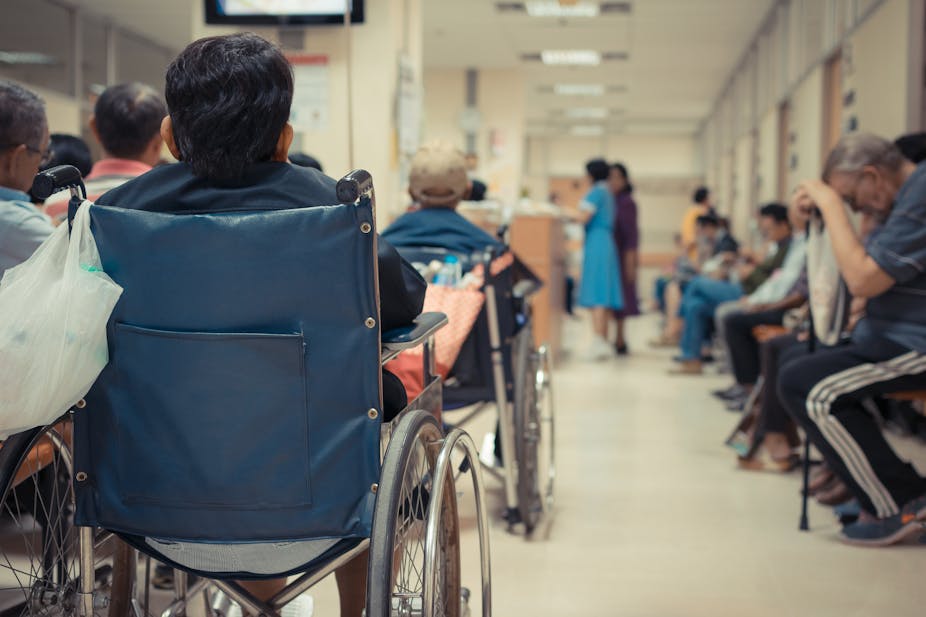The wrecking of fishing vessel Andrea Gail, immortalised in the film The Perfect Storm, was the result of ignorance of the nature and severity of the developing crisis, combined with bad judgements and risk taking by the captain and crew to maximise profits. A similar story may soon play out in the health and social care of old people in England, one that could wreck the system as we know it.
The ageing of the UK population – though in itself a triumph for public health and the NHS – is the first of the “weather systems” contributing to this rumbling perfect storm. According to the Office for National Statistics, in 2014 the median age of the population reached its highest ever level. In addition, the number of people over the age of 65 continued to grow. Population projections suggest this will continue with a next surge due to the “baby boom” of the 1960s coming into old age at around 2030.
Of more immediate concern, however, is the increase in the over 85s. Between 2014 and 2024 this group is projected to grow by a third. Older people, and especially very old people, are most at risk for dementia and other disabling health problems. Predominantly female, they disproportionately use health and social care resources.
Alongside this, there has been a fall in spending on social care for older adults. The Nuffield Foundation reported a 15% drop between 2009-10 and 2012-13, including a 23% reduction in expenditure on home and day care and a 13% reduction in net expenditure on care homes.
As well as putting pressure on the NHS, with hospital discharges being delayed, this is also threatening the viability of the largely privatised care home sector.
The BBC recently reported that about 5,000 care homes – around a quarter of the sector – are at risk of closure because they carry too much debt. This is partly due to reduced social services funding, and, because of the introduction of the so-called national living wage, privatised providers are not making enough profit to cover loan repayments.
Health service commentator Roy Lilley warned of an imminent threat of collapse in the care home market, as Company Watch data covering around 20,000 care homes revealed a funding black hole of half a billion pounds. As Lilley said: “The signs are all there but no one is doing anything.”
Storm clouds
As these two factors rumble on, the indebted, battle-weary and demoralised NHS brings with it gathering clouds. Professor Colin Leys, in a report for the Centre for Health in the Public Interest, estimated that hospitals in England overspent their 2015-16 budgets by £2.5 billion. He also found an acute shortage of GPs, Care Commissioning Groups (CCGs) cutting the range of treatments they will pay for, waiting times for hospital treatments going up, and hospital wards understaffed.

In addition, Leys noted that spending on health in the UK as a proportion of Gross Domestic Product (GDP) is slipping back, and is now at around 8.5% of GDP. This compares badly with France (11.9%), Germany (11%) the Netherlands (11.1%) and other comparable European countries. Leys doesn’t think the latest sustainability and transformation plans from NHS England will solve the problems – neatly summarising this as the impossibility of providing a first-class service on a third-class budget.
One of the most respected health service analysts and the chief executive of the King’s Fund, Chris Ham, wrote recently that “the NHS cannot survive under these financial pressures”. The demoralisation that has resulted from the government’s desire to press ahead with its so-called “seven-day NHS” without any attempt to provide the extra funding and staff needed and a general shortage of doctors, nurses and other clinical staff have added to the pressures.
On the horizon
The ageing of the population was foreseen but the impact of cuts in social services is already biting hard. The NHS is perilously close to crisis and perhaps collapse. Without a recognition of the problems and urgent action from government the brewing perfect storm is likely to strike whenever any further pressure is put on the system, for example by a flu epidemic, the financial collapse of private sector care homes, or some as yet unknown factor.
Already there are worries about quality of care in increasingly stretched hospitals. Austerity is biting all over the public sector. Only a relaxation of austerity in social care, adequate funding of the NHS for the tasks it is asked to perform, proper planning for staffing needs and, ultimately, a repeal of the NHS Act 2012 with its pressures to fragment and privatise NHS services can stabilise the situation.
What is most worrying is that when the crisis comes, as it surely must if warnings are not heeded, it is old people and especially very old people who will suffer most. This seems to be an inevitable consequence of austerity politics according to economics professor and former Greek finance minister Yanis Varoufakis.
We are not here writing just about numbers and policies, this is a real danger to millions of people. We can only hope that if warnings are not heeded and the perfect storm develops, the NHS and the people it serves fare better than the Andrea Gail.

